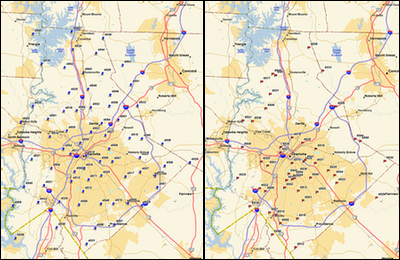


シャーロット・メクレンバーグ洪水情報通知システム (FINS) は、ノースカロライナ州シャーロット周辺の比較的狭い地域に広がる 125 を超える観測所で構成されています。観測所の大部分は降雨量を監視し、残りの観測所は降雨量と水位を監視します。これらの監視所は、事前に設定されたしきい値を超えると、自動ローカル評価リアルタイム (ALERT) プロトコルとアナログ UHF 無線を使用してデータを基地受信機に送信します。
過去には、嵐の際にはパケット衝突と周波数競合により大量のデータが失われていました。ネットワーク全体のパフォーマンスを向上させるために、Distinctive AFWS Designs は、データ スループットを増大し、パケット衝突を減らすことでネットワーク全体の効率を高めるシステムの開発を請け負いました。この目標を達成するために、Distinctive AFWS Designs は CR850、4 つの RF500M 無線モデム、および CRBasic プログラミングのパワーを使用したシステムを設計しました。
マルチ周波数リピーターは、2 つの異なる周波数で着信 ALERT バイナリ データを受信し、デコードします。次に、ALERT データはパス リストと照合され、変換、濃縮されてから、3 番目の RF500M を介して再送信されます。リピーターは 2 つの別々の ALERT ストリームを取り込み、1 つの濃縮ストリームを出力して、再送信をより効率的にします。4 番目の RF500M は、Campbell Scientific の TD-RF プロトコルを利用するために使用されます。LoggerNet ソフトウェアは、ALERT トラフィックの完全なログと統計を収集するために使用されます。さらに、リピーターの構成と管理にも使用されます。
CR800 は、各ポートで受信したバイト数、受信した有効な ALERT パケットの数、再送信された ALERT パケットの数などの統計情報を記録できます。各受信パケットには個別にタイムスタンプが付けられ、パケットに関するその他の統計情報とともに記録されます。データロガーの CPU ドライブにロードされた CSV ファイルは、プログラムによって読み込まれ、解釈されます。この CSV ファイルには、ID のパス リスト (個別または範囲) と、必要に応じて ID を変換する方法に関する情報が含まれています。これにより、プログラムを編集することなく、リピーターをリモートで変更できます。ユーザーがリピーターのパス リストに ID を追加または削除する場合は、マスター スプレッドシートを変更して、ファイルをデータロガーにロードするだけです。これはリモートで実行できます。
FINS は、2 つのマルチ周波数リピーターを並列に導入することで、ネットワークに冗長性を追加し、衝突によって失われる ALERT パケットの数を大幅に削減しました。TD-RF プロトコルと、診断およびステータス監視機能が組み込まれた CRBasic プログラムを使用することで、FINS はシステムのパフォーマンスを定量化し、トラブルシューティングとバックアップのための履歴データを収集し、リモートでメンテナンス機能を実行できます。
ケーススタディの概要
アプリケーション
ALERT洪水警報システム場所
ノースカロライナ州シャーロット使用製品
CR850 RF500M寄稿者
David Haynes, Distinctive AFWS Designs; Don Van Wie, Telos Services; Charlotte USGS WRD参加団体
米国地質調査所(USGS)計測項目
降水量、水位関連ウェブサイト
Mecklenburg County ALERT website参加コンサルタント/インテグレーター
Distinctive AFWS Designs, Inc.PDFで見る